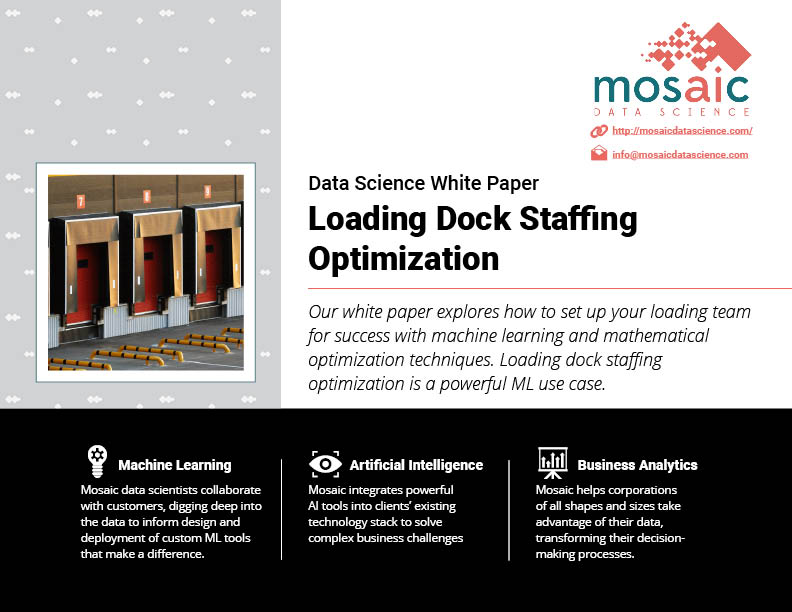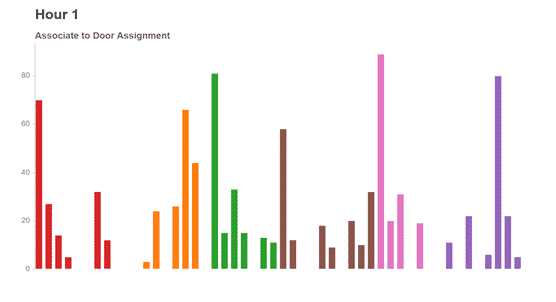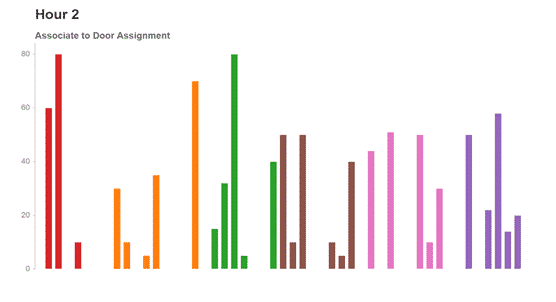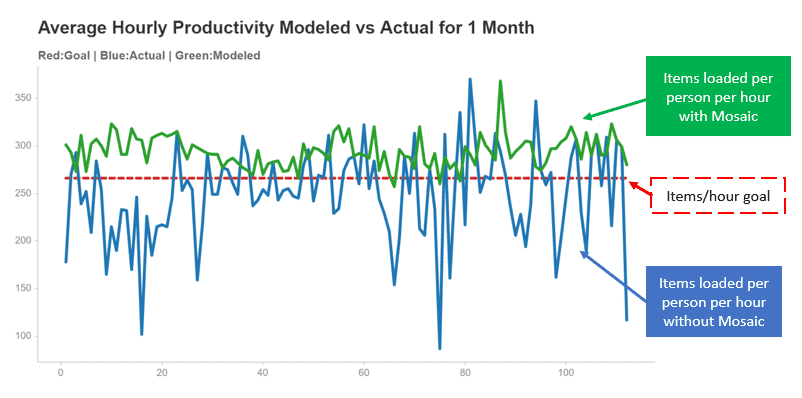Summary
Our white paper explores how to set up your loading team for success with machine learning and mathematical optimization techniques. Loading dock staffing optimization is a powerful ML use case.

Take Our Content to Go
Loading Dock Staffing Optimization | Problem
Increasing the rate at which goods are processed by your distribution center is a matter of optimizing the key operations and decision processes that most impact productivity. The return on investment for even modest improvements to productivity can be significant. Companies across the board look for ways to streamline the movement of goods while minimizing cost and maximizing service levels. Many logistics organizations believe that costly investment in robotic automation is the only path forward in pursuit of these objectives. However, pursuing improvements through robotic automation is often cost-prohibitive for many organizations. Executives need to work within constrained budgets and there are less expensive ways for distribution centers to optimize and modernize decision processes without major, time-consuming investments in automation.
Decision processes in support of jobs that either cannot be or are very difficult to automate are frequently overlooked by out of the box software providers. One such process is the creation of optimal staffing plans for outbound teams loading cartons onto trucks. This problem is the focus of our white paper.
Optimizing Non-Automated Tasks
While increased automation of key distribution center processes continues and the number of people working in these facilities declines, many distribution centers still manage large teams of people dedicated to jobs that are difficult to automate. Mosaic is a big proponent of automation and frequently designs and deploys the deep learning behind these robotics. However, when robotics is cost-prohibitive or not possible, machine learning (ML) and mathematical optimization can recommend staffing decisions to operations managers to help them lead their teams as effectively as possible.
One such process ripe for an ML & mathematical optimization solution is the loading of cartons onto trucks on the outbound dock. Robotics is becoming more widespread for the inbound unloading and ingestion process, but the loading of a truck has been a trickier robotics problem to solve. Simply put, it is much easier to use suction cups to unload cartons from a truck than it is to carefully place each carton into the truck during the loading process.
Volume-Based Staffing Plans
The biggest priorities in logistics are minimizing cost and maintaining high service levels. Productivity (the calculation of which may differ slightly across companies) is generally defined as the number of items processed in a given time period. For our case, productivity is defined as the average number of cartons loaded onto trucks per hour across the entire loading team. This metric helps to encompass both priorities because higher productivity results in both lower labor costs and higher service levels. In other words, more cartons move through the facility at a lower cost-per-carton.
Productivity goals may or may not be informed by the estimated volume of cartons for a particular time period. In some cases, they may be loosely defined by “the best we’ve ever done”. In other cases, they may be defined by poorly estimated volume metrics. Operations managers generally have two levers they can pull to improve or maintain their productivity metrics. The first is building better staffing plans and the second is building better relationships and engaging more with their teams. Top-performing distribution centers have figured out how to pull both levers.
Because of the uncertainty in volume at particular times and in particular areas of the facility, blanket policies are often relied upon for making adequate staffing plans. For example, a manager might decide to assign everyone on their team the same number of doors across the dock (e.g. everyone is assigned five doors each). The problem with approaches like this is that it neglects the fact that volume will differ at each door and will also change throughout the day. So, while the policy is equitable in terms of the number of doors assigned, one team member may be stuck with significantly more cartons to load than another if more volume is diverted to his or her set of assigned doors. Additionally, the team member with fewer cartons to load may not have enough work to do to meet the productivity goal for the hour. Our proposed solution is to shift the focus of equitable workload to a volume-based assignment, rather than a door-count based assignment.
Very often operations managers end up leaning heavily on the relationship building and coaching side of the equation. This is because building an optimal staffing plan is very difficult and time-consuming to do. However, the consequence of suboptimal staffing plans (aside from suffering productivity) is a frantic reassignment of team members as volume fluctuates throughout the day. This leaves managers and their teams stressed and frustrated.
Loading Dock Staffing Optimization | Machine Learning Solution
The Mosaic solution is an optimization algorithm that recommends the best assignment of the loading team to sets of doors across the dock as volume fluctuates throughout the day. The algorithm focuses on building optimal staffing plans quickly so that operations managers can use them to set up their teams for success. While we still see relationship building as a critical component to managing any team in distribution, our proposed solution recommends equitable plans across the dock that assign the team to where the work is going to be, rather than hoping team members are in the right place at the right time.


Bar chart visualizing changing door assignments throughout the day. Each bar is a door, the height of the bar is the volume (blank if zero), and the color is the assigned team member.
Staffing assignments are developed by operations managers who often have to rely on inaccurate estimates of how much volume will flow to each door over the relevant time period. The reason volume estimates are so inaccurate is that predicting hourly volume for each door is a very difficult thing to do! After cartons are ingested into the facility from the inbound side, they move through a complex system of conveyor belts that run at various speeds, traveling with thousands of other cartons simultaneously. This problem is analogous to predicting your ETA on a trip from Washington D.C. to Boston with heavy traffic all the way up I-95. Accurate predictions require the use of advanced machine learning techniques at which companies like Mosaic excel.
Key Benefits of Loading Dock Staffing Optimization
There are several important benefits to using ML and optimization to automate the development of staffing plans. With an optimal set of door assignments, each member of your team will be set up for success in that hour. Inside the facility, you can expect faster loading times. Additionally, loading times will also be more consistent, as you are now able to effectively manage the volatility of carton volume across the dock. These benefits extend outside the facility, leading to decreased dock congestion, faster restocking at the store, and ultimately happier customers.

Example comparison of hourly productivity with and without optimal staffing recommendations. Productivity using the recommendations exceeds the goal and is more consistent over time.
How to get started
Buying an out of the box solution might sound nice, but tuning machine learning takes substantial customization from an experienced data scientist. Promising a plug and play solution does not account for the diversity of data feeding into the algorithm. A classification model such as a random forest model might provide the most explainability, while a support vector machine might produce the most accurate predictions. Failure to understand the mechanics behind these machine learning algorithms leads to a failed project.
Additionally, quickly understanding the art of the possible and what the exact requirements are for your facility is critical to a cost-effective implementation. Our Data Scientists understand the intricacies of different optimization approaches and can help tailor the solution to what you need, helping to avoid thousands of dollars of ongoing commercial licensing fees.

This random forest visualization might seem daunting, but Mosaic can explain to you what the math is telling you about your process.
Hiring a data scientist sounds expensive, but Mosaic frequently tackles these types of problems in a proof-of-concept engagement. Mosaic feels confident in being able to complete a Phase 1 pilot optimization model delivered in 4-7 weeks. Future phases are typically gated to ensure quality control and clear ROI for their customers.
Before moving to future iterations of model development, we collaborate closely with our customers to make sure the model insights make sense to the business. What good are our model insights and recommendations if no one uses them? We develop all solutions with an eye towards usability, explainability, and continuous improvement.
Typical Loading Dock Staffing Optimization Project Structure
Project kickoff: Mosaic typically begins these engagements with an onsite/offsite kickoff to meet stakeholders, become familiar with data sources and systems, clearly define the problem, and learn the applicable business processes. These kickoffs frequently last 2-3 days to make sure a tight project schedule & timeline is in place before development begins.
Mathematical Optimization Model Development: The next step is typically accomplished in 4-7 weeks where we build the optimization model. Frequently our data scientists use historical volume data to estimate the bounds of how much improvement there could be. This gives the customer the opportunity to measure in real terms what the opportunity is for moving toward a full-scale solution and implementation. Multiple machine learning models are piloted and validated. This is where our unique approach of cutting-edge ML and mathematical optimization knowledge and business application shines.
Carton Volume Prediction: Upon delivering the optimization model, Mosaic will gate the next phase of the project. If the business case is there to move toward a full-scale solution, Mosaic then focuses on building an ML model to predict hourly volume by door. This prediction will be used as input to the optimization model when running in production. Typical volume prediction models last 3-6 weeks depending on the complexity of the data.
UI Development: Mosaic builds solutions that people use and all model development has an eye towards usability & explainability. Collaboration with our customers is critical in developing the user interface required for operations managers to interact with the models.
Integration: To achieve the full benefits of ML-driven automation, this system needs to feed into the current workflow stack. This step is critical to ensuring the benefits of the optimized staffing plan recommendations and includes final tweaking and testing before moving to production. Production integration can be as short as 3 weeks. Do not worry, Mosaic has a team of software engineers who excel at integrating ML into production environments.
If you are experiencing staffing challenges, Mosaic is a great partner to consider for boosting productivity and deploying ROI-driven solutions. Drop us a line here to see if we can develop a powerful solution for you.


